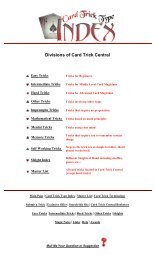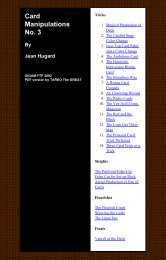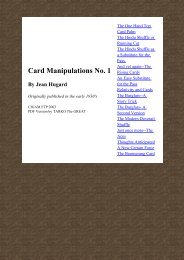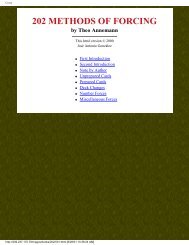The Encyclopedia of Card Tricks-Cover - Umclidet
The Encyclopedia of Card Tricks-Cover - Umclidet
The Encyclopedia of Card Tricks-Cover - Umclidet
Create successful ePaper yourself
Turn your PDF publications into a flip-book with our unique Google optimized e-Paper software.
<strong>The</strong> <strong>Encyclopedia</strong> <strong>of</strong> <strong>Card</strong> <strong>Tricks</strong><br />
[ Main Contents ] [ Next Chapter ] [ Previous Chapter ]<br />
Chapter XVII<br />
~<strong>The</strong> Use <strong>of</strong> Short <strong>Card</strong>s in Magical Effects~<br />
Contents<br />
<strong>The</strong> Short <strong>Card</strong><br />
Another Force<br />
Behind the Pack<br />
<strong>Card</strong> From Nowhere<br />
Color Change, A<br />
Cut <strong>Card</strong> Force<br />
Double Location<br />
Horoscope <strong>Card</strong> Force<br />
Locator, <strong>The</strong><br />
On the Top<br />
Reversed Location, A<br />
Short <strong>Card</strong>, <strong>The</strong><br />
Spelling Trick, A<br />
To Any Number<br />
Vanishing <strong>Card</strong><br />
X-Ray Eyes<br />
PROBABLY the earliest device in the way <strong>of</strong> preparing cards for<br />
secret use in performing tricks was the wide or long card. As the<br />
name implies, one card is a trifle wider or longer than its fellows<br />
and therefore projects slightly either at the end or the side. To<br />
prepare such a pack have all the cards but one slightly shortened<br />
or narrowed by means <strong>of</strong> a printer's guillotine. Later came the<br />
thick card, two cards glued together and dried under pressure,<br />
which can be easily found by the fingers in riffling the edges.<br />
Variations <strong>of</strong> this idea such as cutting the picture <strong>of</strong> a court card<br />
from its frame and gluing it to the face <strong>of</strong> a duplicate court card,<br />
cutting out the spots. and gluing them over the spots <strong>of</strong> a<br />
duplicate card, etc., but all <strong>of</strong> these devices are liable to detection<br />
when the pack is handled by a spectator. <strong>The</strong> most satisfactory<br />
method is that <strong>of</strong> cutting one card a trifle shorter than the rest.<br />
Such a card forms an invaluable key card, it can be found<br />
immediately by riffling the pack and is practically undetectable to<br />
anyone who does not already know <strong>of</strong> it.<br />
As with strippers, to handle the short card intelligently requires<br />
some practice and the card should be lightly cut that the difference<br />
in length would only be revealed by minute inspection. <strong>The</strong> use <strong>of</strong><br />
a card cut so short that the pack divides at it, when riffled, with a<br />
loud click, simply ruins an artifice that is invaluable when<br />
intelligently used. To anyone having a working knowledge <strong>of</strong> the<br />
few indispensable sleights the short card is a very valuable<br />
accessory. <strong>The</strong> danger is that it renders some operations so easy<br />
that the beginner especially comes to depend on it entirely.<br />
<strong>The</strong> drawback to the short card is that it has to be prepared and<br />
therefore can only be used with your own pack. On occasion this<br />
can be overcome by carrying a small pair <strong>of</strong> scissors and working<br />
an effect that entails your leaving the room. By carrying <strong>of</strong>f one <strong>of</strong><br />
the cards in use you can cut <strong>of</strong>f a shaving and secretly return the<br />
card to the pack. <strong>The</strong>re is, however, a plan for getting the same<br />
effect easily and quickly with any pack at a moment's notice. This<br />
was, I believe, devised by Louis Nikola, the English magician, at<br />
any rate he was the first to record it in print in his book <strong>The</strong> Nikola<br />
<strong>Card</strong> System which was published in 1927. <strong>The</strong> plan he<br />
recommends there is to bend up the bottom left-hand corner <strong>of</strong> a<br />
card and work it between the thumb and finger until it is s<strong>of</strong>t. Only<br />
a small corner is necessary, say to within an eighth <strong>of</strong> an inch or<br />
so <strong>of</strong> the edge. When the cards are riffled with the thumb across<br />
this corner, the cards will break at that point, so that such a card<br />
may be put practically to all the uses <strong>of</strong> a short card.<br />
<strong>The</strong> following tricks with a short card have been selected from<br />
<strong>Tricks</strong> with a Short <strong>Card</strong>, by U. F. Grant, the well known magician<br />
and magic dealer. <strong>The</strong>y will serve to illustrate the uses to which<br />
the principle can be put. It would be impossible to give more since<br />
there is hardly a card trick in which a short card could not be<br />
employed. 1 reiterate that the short card should not be used<br />
constantly but only on occasion, when it becomes an invaluable<br />
weapon for throwing the spectators <strong>of</strong>f the track.<br />
Chapter Contents<br />
<strong>Card</strong> From Nowhere<br />
YOU may have a duplicate <strong>of</strong> the short card planted in one <strong>of</strong><br />
your pockets or in any other place you please. Having forced the<br />
short card by the riffle force simply order it to leave the pack and<br />
go. . . to wherever you have the duplicate hidden. Riffle again and<br />
show that the card has vanished, then produce the duplicate.<br />
Chapter Contents<br />
On <strong>The</strong> Top<br />
FORCE the short card by the riffle, or any other way you have at<br />
your disposal, have it replaced and the pack shuffled by a<br />
spectator. Take the pack and bring the short to the top secretly, if<br />
you can, if not then by simply cutting at the short.<br />
Lift the two top cards as one, the top card being short makes this<br />
an easy matter. Replace the two cards as one, order the chosen<br />
card to mount to the top and show it.<br />
Chapter Contents<br />
X-Ray Eyes<br />
PLACE the short card ninth from the bottom. Have a spectator<br />
select a card from anywhere above these nine. Lay the pack on<br />
the table and instruct the spectator to put his card, after noting it,<br />
on top <strong>of</strong> the pack and cut the cards burying his card in the<br />
middle.<br />
Pick up the pack, quietly riffle to the short card and cut at that<br />
point bringing it to the top. State that you have X-ray eyes that<br />
can pierce through the thickness <strong>of</strong> the cards and detect at what<br />
number the chosen card lies. Put the pack on the table and have<br />
the card named. Gaze intently at the back <strong>of</strong> the pack and finally<br />
announce that the card is the tenth card from the top. Let the<br />
spectator deal nine cards and turn up the tenth, his card.<br />
It must be remembered that the chosen card is always one card<br />
farther down than the number at which you place the short card<br />
from the bottom.<br />
Chapter Contents<br />
A Color Change<br />
USE a blue-backed pack and on the bottom place a red-backed<br />
short card. Fan the pack for the free selection <strong>of</strong> a card being<br />
careful not to expose the red-backed card at the bottom. Have the<br />
chosen card noted, put on the top <strong>of</strong> the pack and bury it in the<br />
middle with a complete cut. Square the cards very openly, tapping<br />
the ends and sides on the table to obviate any suspicion that you<br />
night keep the location.<br />
Put the pack behind your back saying that you will try to pick out<br />
the selected cards under impossible conditions. Riffle to the short,<br />
take <strong>of</strong>f that card and the next, the selected card, as one card and<br />
bring them forward showing the face. <strong>The</strong> spectator admits that<br />
the card is his and you ask him if he knows how you could possibly<br />
know it was his card. He says 'No'. 'Because it has a red back' you<br />
say, turning the card and showing the back. Drop the two on the<br />
pack and take <strong>of</strong>f one only. Snap it to show it is a single card but<br />
don't show the face again.<br />
Chapter Contents<br />
Cut <strong>Card</strong> Force<br />
HAVE two or three cards cut short and put them in the middle <strong>of</strong><br />
the pack. Square the cards and place the pack on the table.<br />
Invite a spectator to cut about the middle and the cut will always<br />
be made right above the topmost <strong>of</strong> the short cards, the card that<br />
is to be forced. In using this force always place, or better still hold,<br />
the pack so that the cut is made naturally at the ends.<br />
Chapter Contents<br />
Another Force<br />
WITH the short card on the top <strong>of</strong> the pack, shuffle several<br />
times leaving the card in position on the top. Ask a spectator to<br />
call any number from one to twenty. Suppose ten is chosen. Count<br />
<strong>of</strong>f nine cards keeping them in the same order and put them on<br />
the bottom <strong>of</strong> the pack. Have the spectator look at the top card,<br />
note what it is and replace it. Let him then cut the cards burying<br />
his card in the middle.<br />
As you go to a second person, find the short by riffling and make<br />
the pass at that point, or openly cut the cards. Tell him you will<br />
count down ten cards and have him look at and remember<br />
whatever card is at that position now. Go through the same<br />
routine and he naturally gets the same card as the first man.<br />
Go through exactly the same procedure with a third spectator and<br />
you have forced the same card on all three. Finish the effect in<br />
any way you wish.<br />
Chapter Contents<br />
To Any Number<br />
TO BEGIN have the short card on the bottom, have a card<br />
selected, noted, placed on the top <strong>of</strong> the pack and make a<br />
complete cut. Secretly find the short card and cut, or make the<br />
pass, including the short card, bringing it again to the bottom and<br />
the chosen card to the top. Ask the spectator to call a number,<br />
suppose he says 'Five'. Count <strong>of</strong>f five cards at one time on to the<br />
table and drop the pack on top <strong>of</strong> them. Lift <strong>of</strong>f the top card, then<br />
stop and say, 'Oh, my mistake, this is the sixth card and you said<br />
five. We will start all over again.' Riffle to the short and cut<br />
bringing that card to the bottom. <strong>The</strong> chosen card is now fifth from<br />
the top.<br />
Chapter Contents<br />
Horoscope <strong>Card</strong> Force<br />
HAVE the short card on the bottom and the card you want to<br />
force on the top <strong>of</strong> the pack.<br />
Ask a spectator what month he was born in, suppose he says<br />
'May'. Illustrate then just what you want him to do. Deal the first<br />
card on the table calling it January and continue the deal calling<br />
the next card February, and so on until you reach May. Leave that<br />
card on the top telling him that would be the card he would look at<br />
if he were dealing the cards. Drop the pack on the cards dealt and<br />
give the cards a complete cut. Find the short card and make the<br />
pass, or make a cut openly, bringing the short card to the top.<br />
Hand the pack to the spectator. He counts down to his month,<br />
May, and he will get the card that was originally on the top <strong>of</strong> the<br />
pack, thus making a very novel force. You may write 'Happy<br />
Birthday' on the card beforehand and then force it.<br />
Chapter Contents<br />
A Spelling Trick<br />
PREPARE by placing on the top <strong>of</strong> the pack four cards whose<br />
names will spell with twelve, thirteen, fourteen and fifteen letters<br />
in that order. You may use any cards that fill the requirements<br />
such as the 8C, 7H, KD and 8D. <strong>The</strong> short card you place eleventh<br />
from the bottom and you are ready.<br />
Give the pack a quick riffle shuffle not disturbing the set-up at the<br />
top and bottom. Fan out the four top cards to a spectator and<br />
have him mentally select any one <strong>of</strong> them. Close the fan, drop the<br />
four cards on the top <strong>of</strong> the pack and make a complete cut. Cut<br />
again at the short card and hand the pack to the spectator telling<br />
him to spell his card by removing a card from each letter and on<br />
the last letter to turn the card over. He does so and turns up the<br />
card he thought <strong>of</strong>.<br />
Chapter Contents<br />
<strong>The</strong> Locator<br />
Maxwell<br />
WITH a short card on the top <strong>of</strong> the pack have any card<br />
selected and returned to the top <strong>of</strong> the pack. Hand the pack to be<br />
shuffled. Performer takes back the pack and riffles for the short<br />
card and cuts the pack bringing the short card to the top and the<br />
selected card will invariably be on the bottom to be produced as<br />
desired. <strong>The</strong> chances <strong>of</strong> the short card and the selected card<br />
staying together during the shuffle are about 90 per cent.<br />
Chapter Contents<br />
Behind <strong>The</strong> Pack<br />
U. F. Grant<br />
HAVE the short card on top <strong>of</strong> the pack which you hand to a<br />
spectator. Instruct him to fix on any number in his mind and,<br />
while your back is turned, deal cards one by one face down to that<br />
number, then look at the next card, remember it, replace it face<br />
down on the pack and put the dealt cards on top. Finally, tell him,<br />
he is to make a complete cut. You turn away and the spectator<br />
carries out your instructions.<br />
Turn and take the pack. When the spectator dealt cards from the<br />
top the short card naturally became the bottom card <strong>of</strong> the pile,<br />
and when he replaced the pile on the card he looked at, the short<br />
card was brought immediately above it. All you have to do,<br />
therefore, is to cut the short card and all the cards above it to the<br />
bottom and you have the chosen card on the top <strong>of</strong> the pack. To<br />
simply lift the card and say, 'Here is your card,' would be too<br />
crude a finish. Having the card so easily at your command every<br />
effort should be made to devise some striking method <strong>of</strong> revealing<br />
it.<br />
Chapter Contents<br />
Double Location<br />
SHUFFLE the pack freely, locate the short card and cut it to the<br />
bottom. Invite a spectator to cut the pack into two piles, call the<br />
top half A, the bottom half B, take the top card <strong>of</strong> B, note it and<br />
put it on top <strong>of</strong> A, then place pile B on top <strong>of</strong> pile A. <strong>The</strong> short card<br />
has thus been brought immediately above the spectator's card.<br />
Take the pack, riffle to the short card and cut, complete the cut<br />
and you have the short card on the top <strong>of</strong> the pack.<br />
Ask a second spectator to do exactly as the first spectator did, that<br />
is, make a free cut, look at the card on the top <strong>of</strong> the lower heap,<br />
put it on the upper heap and complete the cut. This time the<br />
chosen card has gone on top <strong>of</strong> the short card and it therefore lies<br />
between the two selected cards. Take the pack, riffle to the short<br />
card and draw it out, but as you do so retain the location by<br />
slipping the tip <strong>of</strong> the left little finger in at that spot. Show the<br />
card as being taken at random, turn it face up and thrust it into<br />
the pack again apparently at random but really being careful that<br />
it goes in at the break.<br />
After giving some plausible reason for the two chosen cards being<br />
attracted to the reversed card, fan the pack with the backs<br />
outwards, the reversed card showing about the center. Draw the<br />
short card upwards about half-way out <strong>of</strong> the pack and do the<br />
same with the card on each side <strong>of</strong> it. Ask the spectators to call<br />
the names <strong>of</strong> their cards. Turn the two cards and show their faces.<br />
Chapter Contents<br />
A Reversed Location<br />
PLACE the short card on the bottom <strong>of</strong> the pack, shuffle<br />
overhand retaining it in that position, then fan the pack and have<br />
a card freely selected. Place the pack down, have the spectator<br />
put his card on the top and make a complete cut, then carefully<br />
square up the cards. Take the pack and riffle it showing the faces<br />
to the audience to prove that there are no reversed cards in it. <strong>The</strong><br />
short card will not be exposed since it will fall with the card<br />
immediately in front <strong>of</strong> it as one card.<br />
In accordance with whatever plot you have arranged for the effect,<br />
fan the pack and show that a card has mysteriously reversed<br />
itself, take out the card next below it, have the spectator name<br />
the card he chose, turn the card and show it.<br />
Chapter Contents<br />
Vanishing <strong>Card</strong><br />
HAVE the pack freely shuffled, take it back and locate the short<br />
card by riffling the ends. You require it to be in a position a little<br />
above the middle <strong>of</strong> the pack and if it is not just right make a cut<br />
to bring it where you want it. Go to a spectator and explain to him<br />
that you will riffle the ends <strong>of</strong> the cards so (riffle them), and that<br />
you want him to call 'Stop', whenever he pleases. Start the riffle<br />
rather slowly and at the call <strong>of</strong> 'Stop' let the cards break at the<br />
short card. Separate the cards at this point and have the spectator<br />
remove the short card, look at it and replace it in any part <strong>of</strong> the<br />
pack he pleases. Square the card and hand them out- to be<br />
shuffled.<br />
Take the pack and order the chosen card to vanish, ruffle the<br />
cards slowly before the spectator's eyes and apparently his card<br />
has left the pack, the short card cannot possibly show since it falls<br />
simultaneously with the card preceding it. Quietly riffle to the<br />
short card and bring it to the ton secretly, or by simply making a<br />
cut. Order the card to return, have it named and turn the top card<br />
showing it has obeyed orders.<br />
After having shown that the card has apparently left the pack you<br />
may go to a second spectator, have him shuffle the pack then<br />
force the short card on him also. Let him take it out holding it face<br />
down. Ask the first spectator to name the card he chose and have<br />
the second person turn over that very card.<br />
Chapter Contents<br />
[ Main Contents ] [ Next Chapter ] [ Previous Chapter ]








